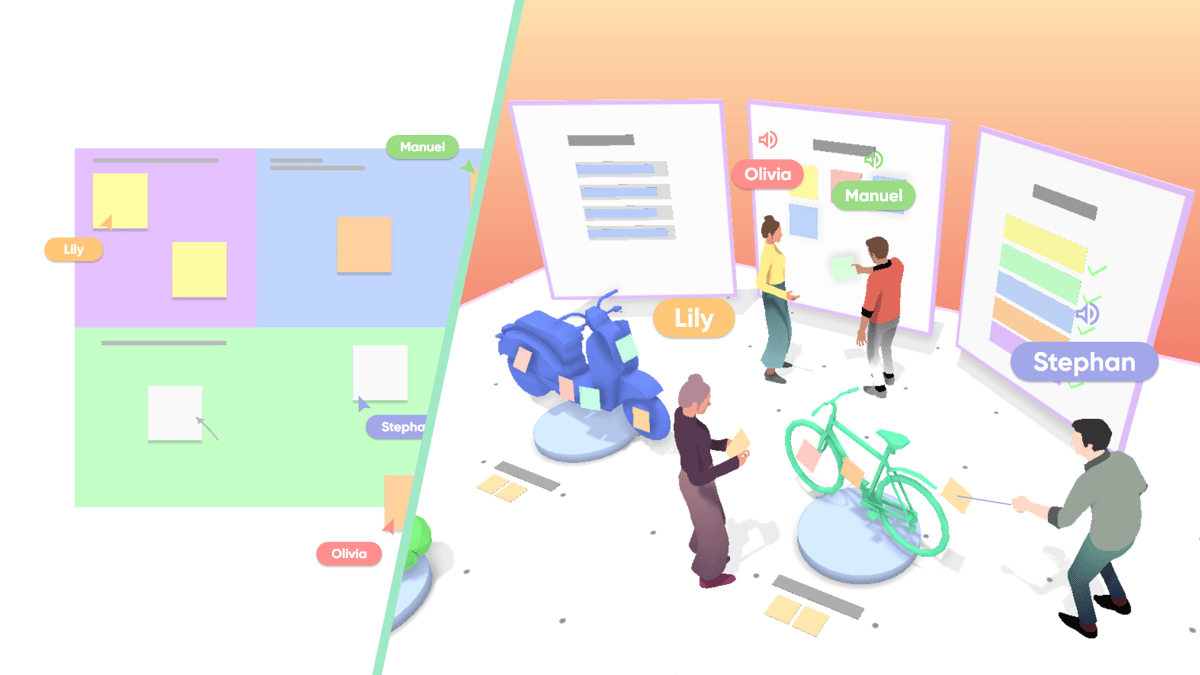The Future of Virtual Collaboration: Exploring the Advantages of 2D vs 3D
If you work in an office environment, chances are high that you already have used multiple online collaboration tools to facilitate working with your team and clients. Since the beginning of 2020, the usage of such tools has seen a considerable rise.
Now, in 2022, it is safe to say that virtual collaboration is here to stay. And to further thrive: trend research predicts the global team collaboration software market size to grow by 9.5% until 2030 annually. This development will bring about new challenges but also chances. Our previous blog article has touched upon the importance of team building in remote environments and how virtual collaboration tools can play a vital part in this.
This blog article will take the topic further and shed light on both 2D and 3D virtual collaboration and its respective advantages.
The two-dimensional approach
One thing is certain: virtual collaboration is never merely one-dimensional. Adding a second dimension will provide us with various tools that should sound familiar to everyone who has worked in a modern-day office.
Among other things, 2D collaboration tools entail the following:
- Group messaging apps
- Video conferencing platforms
- Project management software
- Online whiteboard solutions
Many of these tools had already been used before the remote work trend skyrocketed. However, in the past three years, they have been further developed to better accommodate the changing needs of remote teams.
The 2D digital world of collaboration, as we currently know it, is nothing but convenient. We can see our team through video calls, we can talk to them as if they were next to us in the office, and we can still put sticky notes on whiteboards together.
And yet, it’s hard to shake the feeling that something is missing.
No matter how advanced the two-dimensional world of virtual collaboration becomes, it will always lack the depth we are used to from interacting in person.
This is where we can take it up a notch and add a third dimension to our collaborative efforts.

The third dimension
3D collaboration tools are still in their infancy compared to their two-dimensional counterparts. But they are gaining traction fast! With the Metaverse on the rise, immersive experiences will become more common – not only for games and fun but also for team collaboration.
3D collaboration enables its users to immerse themselves in 3D virtual spaces. Even though the term virtual reality is commonly used, the aim of 3D applications isn’t just to mimic the real world. It is rather about picking the best parts of the physical world and translating them into a virtual one.
As a result, 3D solutions provide us with collaborative spaces that seem familiar but at the same time, will allow us to move, work and think more freely and creatively. Ideally, 3D tools combine the convenience of 2D solutions with the depth of face-to-face interactions in the real world.
But there is even more to it! Virtual reality resembles what we are used to in everyday life in the offline world. That’s why navigating a virtual world comes much more naturally and intuitively than using a 2D whiteboard solution.
However, when it comes to accessibility, many virtual collaboration tools are still lagging compared to 2D solutions. Let’s have a closer look.
Accessibility, inclusivity & fun
2D collaboration can be as simple as it gets. Let’s take an online whiteboard solution as an example.
You and your team simply log on to your browsers and can start collaborating in real-real time. The same goes for group messaging apps and, to some extent, video conferencing platforms (participants will obviously need a webcam).
Many 3D applications, however, require their users to work with additional gadgets, such as VR headsets. This results in higher entrance barriers and costs and makes usage somewhat inconvenient. These barriers are likely the main reason virtual reality applications haven’t yet caught on for broader audiences.
Does this render all 3D collaboration tools impractical? The answer is no.
Luckily there are 3D tools, such as VISPA, which do not require any additional gadgets. You and your team members just need to log on and start collaborating. It is accessible, it’s inclusive, and it’s fun!
Discover Virtual Collaboration.
Reserve your private session with one of our experts.